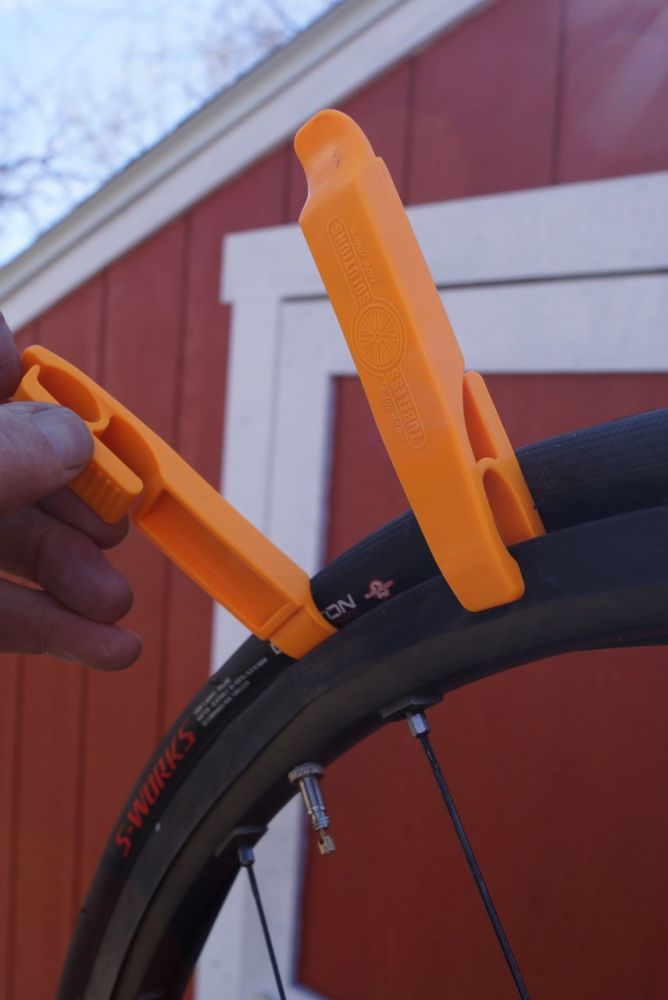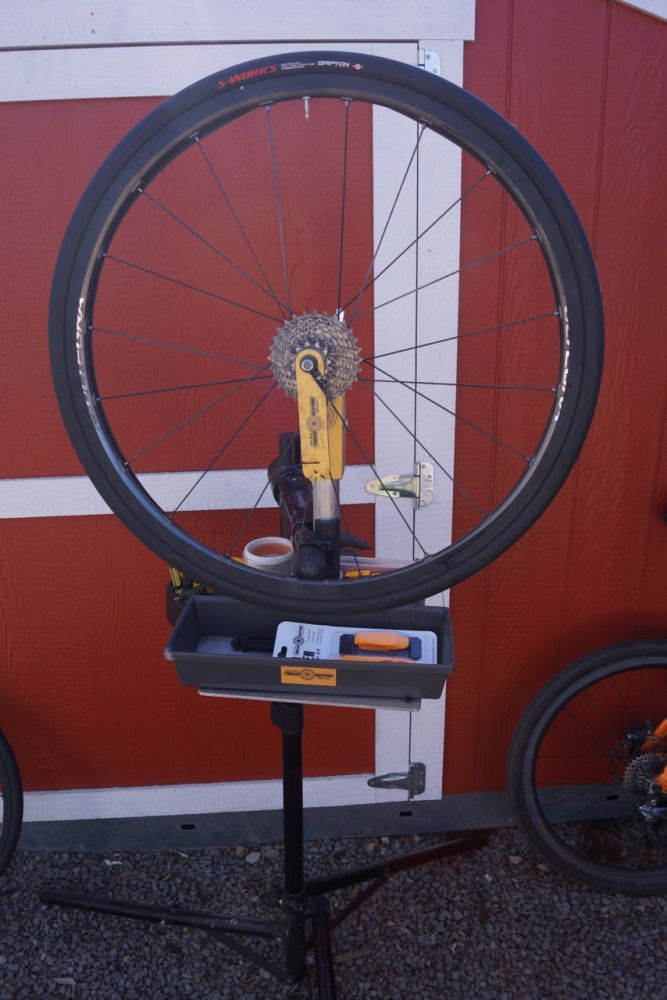Heading out the door? Read this article on the new Outside+ app available now on iOS devices for members! Download the app.
Dear Readers,
After trying some other options, I’m revisiting this question from Mark about how best to set up tubeless tires for a travel bike so they can be deflated and still be re-inflated at one’s travel destination with a mini-pump.
[related title=”More Technical FAQ” align=”right” tag=”Technical-FAQ”]
First off, I realized that I had forgotten that I was not using the same wheels in both cases I mentioned. I was not using Ultegra tubeless wheels on my travel bike before, when I was able to deflate the tires and shove them into the bike case without the bead coming unseated from the rim ledge. Currently, I have indeed not been able to deflate a tire on those Ultegra tubeless wheels without the bead coming unseated. But before, I actually had a set of Dura-Ace Scandium tubeless wheels with Hutchinson Fusion 2 tubeless 700x23C tires on them that never came unseated when I’d travel. I’m pretty sure I had used a number of different sets of these same tires on them, always without incident and never requiring anything other than a mini pump to inflate them at my destination.
After I sold that bike, I got the Ultegra tubeless wheels for my current travel bike. A reader pointed out to me that he had had a similar issue and had measured the rim ledges on his Dura-Ace wheels as being larger in diameter than his Ultegra wheels, hence the difference in bead seating. Since I no longer have those Dura-Ace wheels, I can neither confirm nor refute this.
In any case, what I have are Ultegra tubeless wheels that have worked fine with tubeless tires as long as I never deflated them completely. However, the tires must be deflated completely in order to fit in an S&S travel case, and I had long ago given up on being able to use tubeless tires when traveling. But now I have new hope with Fatty Strippers, which are flat latex strips you mount under a fat-bike tire. With them, you can run 5-inch-wide tires tubeless at 2 psi (!!) without concern about burping air and consequent unpleasantness in cold temperatures.
Skinny Strippers are the narrow (75mm-wide) brethren made for road rims of the 150mm-wide Fatty Strippers. I have anecdotally heard of riders being able to run very low pressures (as low as 15psi) with cyclocross clinchers and Skinny Strippers without ever burping air out under hard cornering. It also occurred to me that another advantage of both Skinny Strippers and Fatty Strippers is that they seal the tire’s air chamber completely from the rim bed, which would seem to eliminate the concern about corrosion of aluminum rims by some latex-based sealants.
You install Skinny Strippers by pushing the valve stem through the hole in the latex strip first and then stretching the strip so it overlaps both sides of the rim. Besides making the rim’s bead shelves slightly larger in diameter, which should help the tire bead stay up on the rim shelf, the Skinny Stripper over time becomes glued to the tire, if a latex-based sealant is used inside. The tire/Skinny Stripper combo is supposed to end up still holding air, even when the tire is pulled off of the rim, along with the Skinny Stripper adhered to it. You can see this happening in this video of Fatty Stripper tire removal:
I set up three sets of tires with Skinny Strippers – a set of 700x33C Challenge Chicane open tubulars on that same set of Ultegra tubeless wheels, a set of 700x42C Specialized Sawtooth 2Bliss (tubeless-ready) clinchers on FSE deep-section carbon disc-brake wheels, and a set of 700x28C Specialized Turbo S-Works tubeless-ready tires on my Ultegra tubeless wheels. I used Stan’s NoTubes sealant in them, because a latex-based sealant is required in order for the gluing to the latex strip to occur; Caffélatex, which I often use to prevent rim corrosion, has no latex in it.
The CX open tubulars were an experiment to see if this system is so robust that I could run tires as tubeless that are otherwise impossible to do so. Disclaimer: never try to run road tires tubeless that are not specifically made to be tubeless; it’s dangerous! I merrily once tried this umpteen years ago at the beginning of the tubeless era with a pair of 700x23C Vittoria open tubulars and was lucky to avoid injury when the front tire blew off while I was riding downhill in front of my house with no helmet on; I’d only just made it out the driveway before it blew. Both beads blew off simultaneously, leaving me trying to gently bring the bike to a stop while keeping the front rim from sliding off of the flattened-out tire casing on a slippery film of Stan’s sealant (open tubulars tires lay flat when not on a rim; they do not hold a clincher shape).
Anyway, I guess this memory had slipped far enough into my subconscious that I thought perhaps I could get away with this with a cyclocross open tubular at 30psi. I was wrong. First, I could not get them to seal, despite adding more sealant on subsequent days and doing the “tubeless wobble” with the wheels over and over, day after day, trying to get sealant to go to the areas that soap suds indicated were leaking. Finally, I made the poor decision to try to get them to seal by riding them. The rear tire blew off with an enormous bang, scaring a pair of hikers I was passing on a dirt trail a couple of kilometers from my house.



This was my second attempt with the 700x42C Sawtooth tires; those were tires that I had run tubeless last summer for many months and had never gotten them to seal completely. That time, I had mounted them on XTR tubeless rims with Caffélatex sealant, and as long as I rode them every day, they did not go completely flat overnight. However, I was pumping them a lot daily, and if I ever did not do that, they were dead flat in another day or two. So, if I could get them to seal sustainably on non-tubeless carbon clincher rims, that would constitute a real victory for Skinny Strippers.
Finally, the 700x28C Turbo S-Works TR tires were the ones that I was really counting on. As I mentioned before, I’m leading a bike trip from Venice to Rome in June, and we will spend one day riding the dirt roads of the Chianti region — the roads of L’Eroica and Strade Bianche Eroica Pro near Siena. I want a larger tire (28C is as big as my travel bike will accept) with a bombproof and cut-resistant tubeless system I can run at low pressure and that I can deflate and put in my travel case and be confident that I can inflate again when I get to Italy. I intend to use the same tires for the entire trip, so I also want them to roll fast on paved roads as well as on strade bianche. These 2016 Turbo SWs have a new dual compound, 120tpi casing, and D940 breaker strip that together are claimed to offer 30 percent more puncture resistance and five percent less rolling resistance than the already-fast 2014 Turbo SWs that topped our rolling-resistance test two years ago.
Getting tight tubeless-ready road tires on over the latex Skinny Strippers, which slightly increase the rim-ledge diameter and also stick to the tire beads, is not easy. To make it less of an odyssey, I resorted to using a Tubeless Solutions Tubeless Tower Workstation, along with Tubeless Solutions Bead Biters.
The Tubeless Tower Workstation is like a single-leg truing stand, except that it can flip over to 90 degrees and allow you to flip the wheel between horizontal and vertical. It has a little platform under the wheel with a tray you can fill with soapy water so that you can slather the tire with soap suds for mounting as well as for checking for sealing. Forget struggling with the wheel held down against the floor or loose in front of you on a workbench and getting junk in it from the floor or bench; the workstation holds the wheel securely straight in front of you, at whatever height you set the bike stand that you’ve clamped it into.
Bead Biters are much more than glorified tire levers. Yes, they do the work of a tire lever, but on their other end, they have a little alligator jaw with an overbite. They make tubeless tire mounting easier in two ways. First, if the bead won’t stay down in the rim valley (thus reducing the overall circumference the bead is sitting on, hence easing the mounting of the last section of bead at the valve stem) you can put three or four Bead Biters around the rim, longer lower jaw to the outside, to keep the bead in the center of the rim. Secondly, and most importantly, they make getting that last bit of bead over the rim at the valve stem much easier. You clamp a Bead Biter onto the rim on each side of the valve stem to prevent the bead section that is already in the rim from popping over it when you pry the last section of bead over the rim at the valve stem.









The stickiness of Skinny Strippers and the extra steps involved make tire mounting take longer, although tire sealing is probably quicker. However, one thing that can be very time-consuming, and an absolute necessity with rim-brake wheels, is to trim the Skinny Stripper edges back to flush with the rim edge. It sounds like this should be easy with a sharp knife, but I found that not to be the case. You are supposed to just stretch it away from the rim and cut it, but, just like cutting an un-inflated balloon, it pulls and tugs and then suddenly breaks, leaving lots of hanging flaps. I ran out of patience eventually and have been riding with lots of little flaps making noise against my brake pads. Over time, some of them have gotten shredded off, and I imagine eventually, I will have either gone back and cut or broken off every little one, or they will have gotten ground off by my brakes. But if they make those Turbo SWs work for tubeless travel, I won’t mind in the long run.
I set up the Sawtooths and the Turbo SWs last week and rode them a few times. Then I went away for the three-day President’s Day weekend, and when I came back, the rear Turbo and the front Sawtooth were flat, while their mates were still at full pressure. This already was a win with one of the Sawtooths. I rode both bikes again yesterday and then did the tubeless wobble again with the two that had not been holding air, trying to get sealant to fill pinholes that water immersion showed were still leaking. This morning, the front Sawtooth had dropped from 32psi to 12psi, and the rear was still at 32psi.
Both Turbos were still at 80psi today, so it was time to do the ultimate test I’m interested in. I deflated them completely. The beads stayed on the rims, and the Skinny Strippers stayed adhered to the tire edges. I easily inflated both tires with a hand pump. I may be in business for shoving them in a travel case and depending on being able to inflate them when I get to Italy! I’m going to be very happy on the strade bianche if that’s the case.
― Lennard
